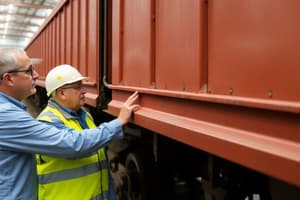Podcast
Questions and Answers
Under what condition can a request for weighment be disallowed if the consignment is received in a covered wagon?
Under what condition can a request for weighment be disallowed if the consignment is received in a covered wagon?
- If the consignment is not of perishable nature.
- If the consignment is less than the booked quantity.
- If there is evidence of tampering in transit. (correct)
- If the seals of the loading station are broken.
What circumstance may lead to the disallowance of a weighment request based on the nature of the consignment?
What circumstance may lead to the disallowance of a weighment request based on the nature of the consignment?
- The consignment has been stored for extended periods.
- The consignment is from a recognized supplier.
- The consignment is delivered after the scheduled time.
- The consignment is perishable and likely to lose weight during transit. (correct)
Which of the following statements is NOT true regarding the weighment of consignment?
Which of the following statements is NOT true regarding the weighment of consignment?
- Weighment requests must be made in writing.
- Charges are applicable for weighment services.
- Weighment is allowed at owner's risk regardless of conditions. (correct)
- Weighment may be disallowed due to yard congestion.
Which option describes a scenario where weighment may be allowed without prejudice to the railway's liability?
Which option describes a scenario where weighment may be allowed without prejudice to the railway's liability?
What is a prerequisite for weighment to be feasible according to the regulations?
What is a prerequisite for weighment to be feasible according to the regulations?
What should be recorded in the wagon exchange book immediately after wagons are received or dispatched?
What should be recorded in the wagon exchange book immediately after wagons are received or dispatched?
What should happen as soon as inward loaded wagons are received?
What should happen as soon as inward loaded wagons are received?
What type of memo is prepared after a loaded wagon is placed for unloading?
What type of memo is prepared after a loaded wagon is placed for unloading?
When a loaded wagon is released for removal, who prepares the memo?
When a loaded wagon is released for removal, who prepares the memo?
How should the placement and release memos be filed?
How should the placement and release memos be filed?
What should be done if there is an undue delay in placing wagons for unloading?
What should be done if there is an undue delay in placing wagons for unloading?
What format is used for preparing a release memo?
What format is used for preparing a release memo?
What must be recorded in the wagon transfer register concerning the timing of wagons?
What must be recorded in the wagon transfer register concerning the timing of wagons?
Who needs to sign the wagon transfer register when wagons require unloading by owners?
Who needs to sign the wagon transfer register when wagons require unloading by owners?
What happens if a wagon is not released in the time allowed?
What happens if a wagon is not released in the time allowed?
What should be maintained when wagons are unloaded by the railway?
What should be maintained when wagons are unloaded by the railway?
What should be recorded in the register by the contractor unloading wagons?
What should be recorded in the register by the contractor unloading wagons?
Which detail is NOT required to be submitted with the billing for demurrage charges?
Which detail is NOT required to be submitted with the billing for demurrage charges?
Where should the total amount of demurrage charges due be shown?
Where should the total amount of demurrage charges due be shown?
When demurrage is not due, what should the Station Master include on the bill?
When demurrage is not due, what should the Station Master include on the bill?
How are the pages of the wagon transfer register numbered?
How are the pages of the wagon transfer register numbered?
What should be done immediately if defective seals are found on a wagon?
What should be done immediately if defective seals are found on a wagon?
Which document should the wagon labels be compared with upon receipt?
Which document should the wagon labels be compared with upon receipt?
Who should remove seals and labels from the wagons?
Who should remove seals and labels from the wagons?
What must be noted in the tally book before opening a wagon?
What must be noted in the tally book before opening a wagon?
For how long should seals and labels be preserved?
For how long should seals and labels be preserved?
What should be done with seals and labels in the event of a claim or shortage?
What should be done with seals and labels in the event of a claim or shortage?
How should the unloading tally book be filled out?
How should the unloading tally book be filled out?
What action should be reported if there is a discrepancy between the weight on the wagon label and the invoice?
What action should be reported if there is a discrepancy between the weight on the wagon label and the invoice?
What is the primary purpose of the unloading tally book?
What is the primary purpose of the unloading tally book?
What should be done with the tape after removing seals?
What should be done with the tape after removing seals?
What is the minimum percentage of small consignments that should be reweighed immediately after unloading?
What is the minimum percentage of small consignments that should be reweighed immediately after unloading?
When should packages showing signs of pilferage or damage be reweighed?
When should packages showing signs of pilferage or damage be reweighed?
What should be done in case discrepancies are found between the invoiced weight and the weight found on weighment?
What should be done in case discrepancies are found between the invoiced weight and the weight found on weighment?
What should be recorded after the result of the weighment or reweighment?
What should be recorded after the result of the weighment or reweighment?
Who should be notified of appreciable underweighments that could result in revenue loss?
Who should be notified of appreciable underweighments that could result in revenue loss?
What should be done with the invoices or labels endorsed for weighment at the destination station?
What should be done with the invoices or labels endorsed for weighment at the destination station?
In the case of irregular size or weight packages, what is the procedure regarding reweighing?
In the case of irregular size or weight packages, what is the procedure regarding reweighing?
What must be advised telegraphically to the destination station if an undercharge recovery is relevant?
What must be advised telegraphically to the destination station if an undercharge recovery is relevant?
Which document must contain a suitable note regarding discrepancies in weighment?
Which document must contain a suitable note regarding discrepancies in weighment?
What is the purpose of having a check on the weighed invoices at receiving stations?
What is the purpose of having a check on the weighed invoices at receiving stations?
What must the Trains Clerk do immediately after placing a loaded wagon in position for unloading?
What must the Trains Clerk do immediately after placing a loaded wagon in position for unloading?
In what manner should the particulars of wagons received or dispatched be recorded?
In what manner should the particulars of wagons received or dispatched be recorded?
What is required to be recorded in the wagon exchange book when there is an undue delay in placing wagons for unloading?
What is required to be recorded in the wagon exchange book when there is an undue delay in placing wagons for unloading?
How should the release memo be filed after it has been prepared?
How should the release memo be filed after it has been prepared?
Which document must contain the details of wagons placed for unloading?
Which document must contain the details of wagons placed for unloading?
What type of acknowledgments must be obtained in the process of preparing memos?
What type of acknowledgments must be obtained in the process of preparing memos?
What is the implication of not filing the placement memo correctly?
What is the implication of not filing the placement memo correctly?
What should be done immediately upon discovering defective seals on a wagon?
What should be done immediately upon discovering defective seals on a wagon?
What should be done if a wagon is removed for shunting after being positioned for unloading?
What should be done if a wagon is removed for shunting after being positioned for unloading?
When comparing wagon labels with invoices, what must be reported if discrepancies are found?
When comparing wagon labels with invoices, what must be reported if discrepancies are found?
How long should seals and labels be preserved before destruction?
How long should seals and labels be preserved before destruction?
Who must countersign the remarks made in the wagon transfer register regarding wagon unavailability?
Who must countersign the remarks made in the wagon transfer register regarding wagon unavailability?
What does the Post system aim to achieve in managing inward loose goods?
What does the Post system aim to achieve in managing inward loose goods?
What action should be taken if the intermediate weighbridge station's weighment result is not communicated to the destination station?
What action should be taken if the intermediate weighbridge station's weighment result is not communicated to the destination station?
What is required to be noted in the tally book before opening a wagon?
What is required to be noted in the tally book before opening a wagon?
What must be done with the tape after removing the seals from a wagon?
What must be done with the tape after removing the seals from a wagon?
Under what conditions can a reweighment request be considered at the destination station?
Under what conditions can a reweighment request be considered at the destination station?
What must be recorded on a wagon label when a consignment is removed?
What must be recorded on a wagon label when a consignment is removed?
What should happen if no reweighing facilities exist at the destination station?
What should happen if no reweighing facilities exist at the destination station?
How should the position at each unloading berth be documented daily?
How should the position at each unloading berth be documented daily?
Who is authorized to remove seals and labels from wagons?
Who is authorized to remove seals and labels from wagons?
What detail should be ensured when recording entries on the back of wagon labels?
What detail should be ensured when recording entries on the back of wagon labels?
Who has the authority to permit the reweighment of goods booked in wagon loads at the destination station?
Who has the authority to permit the reweighment of goods booked in wagon loads at the destination station?
What should be included in the unloading tally book when unloading goods from a wagon?
What should be included in the unloading tally book when unloading goods from a wagon?
What happens to the unloading berth number in the Post system?
What happens to the unloading berth number in the Post system?
What should be done with the labels and seals in the event of a shortage or dispute?
What should be done with the labels and seals in the event of a shortage or dispute?
What should be done if an undercharge recovery is deemed relevant?
What should be done if an undercharge recovery is deemed relevant?
What responsibility does the authorized staff have regarding the collection of charges?
What responsibility does the authorized staff have regarding the collection of charges?
What specific information should be compared between the wagon labels and the invoice?
What specific information should be compared between the wagon labels and the invoice?
When should the goods be tallied out of the wagon?
When should the goods be tallied out of the wagon?
What is required of the Delivery Clerk regarding the wagon label during cargo handling?
What is required of the Delivery Clerk regarding the wagon label during cargo handling?
What must be indicated on telegram messages when reporting the unloading of goods?
What must be indicated on telegram messages when reporting the unloading of goods?
What action is required when packages are found missing from wagons with broken seals?
What action is required when packages are found missing from wagons with broken seals?
When should the telegram regarding missing packages be sent to the Chief Commercial Superintendent?
When should the telegram regarding missing packages be sent to the Chief Commercial Superintendent?
What form should be used to notify damages or deficiencies after unloading?
What form should be used to notify damages or deficiencies after unloading?
In the event of a theft from the station yard, what process is followed?
In the event of a theft from the station yard, what process is followed?
Which of the following statements is true about notifying deficiencies?
Which of the following statements is true about notifying deficiencies?
What must be done when a shortage is reported valued at Rs. 500 or above?
What must be done when a shortage is reported valued at Rs. 500 or above?
When should the details of complaints due to missing packages be addressed to the Government Railway Police?
When should the details of complaints due to missing packages be addressed to the Government Railway Police?
Which element is NOT required to be preserved after removing the seals?
Which element is NOT required to be preserved after removing the seals?
Flashcards
Wagon Exchange Book
Wagon Exchange Book
A record-keeping document used to log wagon movement (loaded or empty) at a railway station.
Wagon Placement
Wagon Placement
Positioning inward loaded wagons so they are ready for unloading.
Placement Memo
Placement Memo
A document prepared by the Trains Clerk that records the details for an unloaded wagon, when made ready.
Goods Clerk Acknowledgement
Goods Clerk Acknowledgement
Signup and view all the flashcards
Release Memo
Release Memo
Signup and view all the flashcards
Wagon Transfer Register
Wagon Transfer Register
Signup and view all the flashcards
Trains Clerk
Trains Clerk
Signup and view all the flashcards
Form Com/L-16
Form Com/L-16
Signup and view all the flashcards
Consignee's signature
Consignee's signature
Signup and view all the flashcards
Demurrage charges
Demurrage charges
Signup and view all the flashcards
Supplementary Goods Tariffs
Supplementary Goods Tariffs
Signup and view all the flashcards
Unloading by owners
Unloading by owners
Signup and view all the flashcards
Unloading by railway
Unloading by railway
Signup and view all the flashcards
Contractor unloading
Contractor unloading
Signup and view all the flashcards
Handling bill
Handling bill
Signup and view all the flashcards
Wagon Seal Inspection
Wagon Seal Inspection
Signup and view all the flashcards
Defective Seal Action
Defective Seal Action
Signup and view all the flashcards
Wagon Label Verification
Wagon Label Verification
Signup and view all the flashcards
Seal Removal Procedure
Seal Removal Procedure
Signup and view all the flashcards
Seal Tape Preservation
Seal Tape Preservation
Signup and view all the flashcards
Seal Preservation Period
Seal Preservation Period
Signup and view all the flashcards
Unloading Tally Book
Unloading Tally Book
Signup and view all the flashcards
Tallying Method
Tallying Method
Signup and view all the flashcards
Discrepancy Reporting
Discrepancy Reporting
Signup and view all the flashcards
Invoice Matching
Invoice Matching
Signup and view all the flashcards
Weighment Request
Weighment Request
Signup and view all the flashcards
Railway Risk Rate
Railway Risk Rate
Signup and view all the flashcards
Intact Seals
Intact Seals
Signup and view all the flashcards
Perishable Goods
Perishable Goods
Signup and view all the flashcards
Congestion in Yard
Congestion in Yard
Signup and view all the flashcards
Unbooked Goods
Unbooked Goods
Signup and view all the flashcards
Reweighment
Reweighment
Signup and view all the flashcards
Small Consignments
Small Consignments
Signup and view all the flashcards
Irregular Size
Irregular Size
Signup and view all the flashcards
Pilferage
Pilferage
Signup and view all the flashcards
Station Master
Station Master
Signup and view all the flashcards
Undercharged
Undercharged
Signup and view all the flashcards
Tally Book
Tally Book
Signup and view all the flashcards
Discrepancies
Discrepancies
Signup and view all the flashcards
Appreciable Underweighment
Appreciable Underweighment
Signup and view all the flashcards
Reweighment at Destination
Reweighment at Destination
Signup and view all the flashcards
Reweighment by Owners' Request
Reweighment by Owners' Request
Signup and view all the flashcards
Weighment Facilities
Weighment Facilities
Signup and view all the flashcards
Divisional Commercial Superintendent
Divisional Commercial Superintendent
Signup and view all the flashcards
Endorsed Invoices
Endorsed Invoices
Signup and view all the flashcards
Wagon Seals Broken
Wagon Seals Broken
Signup and view all the flashcards
Missing Packages
Missing Packages
Signup and view all the flashcards
Reporting Missing Packages
Reporting Missing Packages
Signup and view all the flashcards
High Value Loss Reporting
High Value Loss Reporting
Signup and view all the flashcards
Missing Packages from Yard
Missing Packages from Yard
Signup and view all the flashcards
Damage or Deficiency Reporting
Damage or Deficiency Reporting
Signup and view all the flashcards
Damage Reporting Form
Damage Reporting Form
Signup and view all the flashcards
Post System
Post System
Signup and view all the flashcards
Unloading Berth
Unloading Berth
Signup and view all the flashcards
Wagon Label
Wagon Label
Signup and view all the flashcards
Wharfage Charges
Wharfage Charges
Signup and view all the flashcards
Delivery Clerk
Delivery Clerk
Signup and view all the flashcards
Study Notes
Wagon Exchange Book
- Maintained at all stations by the Trains branch or other operating department
- Records wagon details (loaded/empty, received/dispatched)
- Should be filled correctly in ink
Placing Inward Loaded Wagons
- Wagons must be placed for unloading as soon as possible
- Any delay reasons should be recorded in the exchange book
Placement and Release Memo (Placement Memo)
- Prepared in duplicate (carbon copy process) using Appendix XV/A
- Shows wagon details for unloading
- Pencil copy given to Goods Clerk; acknowledgement obtained on carbon copy
- Filed in the goods shed serially by receipt date
Wagon Transfer Registers (Form Com./L-16)
- Records wagon placement and release times
- Machine-numbered pages
- Similar to tally books (para 1513)
Wagon Unloading by Owners
- Consignee/authorized agent signature is required in the register after placement/release
- Free time for release is given in Supplementary Goods Tariffs
- Demurrage charges recorded and collected from consignor.
Wagon Unloading by Railway
- Separate transfer register maintained
- Contractor's signature for unloading to avoid disputes
- Demurrage charges recorded, but not included in the station balance sheet
- Station Master's full signature on the relevant handling bill
Post System
- Used for checking loose goods unloading, account of demurrage and wharfage charges
- Rails at unloading berths are serially numbered
- Unloading berth number recorded on wagon labels (kept with delivery clerk)
- Daily position at each berth recorded
- Demurrage, wharfage charges collected
Examination of Seals, Labels, Etc.
- Station staff examines seals, labels, rivets, etc
- Examination done in the presence of Seal Checker/Rakshak and train guard
- Defective seals require immediate wagon content checks
Removal of Rivets, Seals, and Labels
- Only authorized staff removes seals and labels
- Condition of seals, labels, and rivets should be noted in tally book
Preservation of Seals and Labels
- Seals and labels stored for 6 months
- Destroyed after 6 months, except in cases of disputes/claims
- Submitted along with missing or damaged goods reports
Tally Book
- Maintained for unloading using form Com/T-1 Rev
- Tallying should be done individually, or where possible, collectively
- Wagon numbers checked in tallying
Unloading of Goods
- Each package checked carefully for breakage and damage.
- Valuable goods supervised by the Station Master
Deficiency and Damage
- Damage and deficiency advices prepared on Form Com/D-3
- Additional details (position, weight, water damage, etc) are necessary
- Registers for damage and deficiency advices
- Information about issuing a damage and deficiency postcard
Packages Found Missing
- Action depends on whether seals, sheets, or check lines are broken or intact
- Copy of the telegram to the Chief Commercial Superintendent and Divisional Office if shortage above Rs 500
- If goods are missing from yards, goods sheds, or platforms, the process is similar
Excess Packages
- If any packages are found to be in excess of those expected, it should be notified to the booking and the last transhipment stations via telegram.
Reweighing of Goods at Receiving Station
- Ten percent of small consignments must be reweighed
- Consignments of irregular sizes/weights must be reweighed
- Result of weighment recorded in invoice/unloading tally/goods delivery etc.
- Weighment at intermediate stations is notified to destination and Traffic Accounts office.
Discrepancies on Reweighment
- Discrepancies between invoiced and actual weight need to be handled according to I.R.C.A. Goods Tariff
- Significant underweighing to be reported to higher authorities with copies to the Traffic Accounts Office
- Consignments with endorsed invoices need to be weighted at destination
Reweighment on Request
- Railways will not weigh consignments on a general basis
- Exceptions need approval including reason, and are under specific conditions.
Delayed Consignments
- If consignments are not delivered in a reasonable time, enquiries start immediately
- Relevant details recorded in the Goods Delivery Book
Studying That Suits You
Use AI to generate personalized quizzes and flashcards to suit your learning preferences.
Related Documents
Description
Test your knowledge on the procedures for maintaining the Wagon Exchange Book and the protocols for placing inward loaded wagons. This quiz covers important details like recording unloading and transfer processes, and the importance of signatures in the wagon unloading register.




